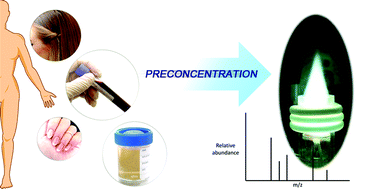Current developments in clinical sample preconcentration prior to elemental analysis by atomic spectrometry: a comprehensive literature review†
Abstract
Sample preconcentration is important for metal analysis in complex clinical matrices due to the low concentration of analytes and high salt content. The limited amount of sample available also increases the challenges of extraction and determination of the analytes. In spite of the increase in sensitivity of instruments, such ultra-trace levels of the metals are still difficult to determine accurately. Researchers have adopted various strategies to improve the efficiency and selectivity of the extraction. The use of chemicals and time for analysis can also be reduced by scaling down the analysis to the micro-level. This review discusses four aspects of the recent development in metal preconcentration in clinical samples, namely the use of ionic liquids (ILs) in extraction, sorption by nanomaterials, preconcentration using surfactants, and automation. The publications reviewed cover the period between 2008 to late 2013.

- This article is part of the themed collection: 2014 Young Analytical Scientists

 Please wait while we load your content...
Please wait while we load your content...